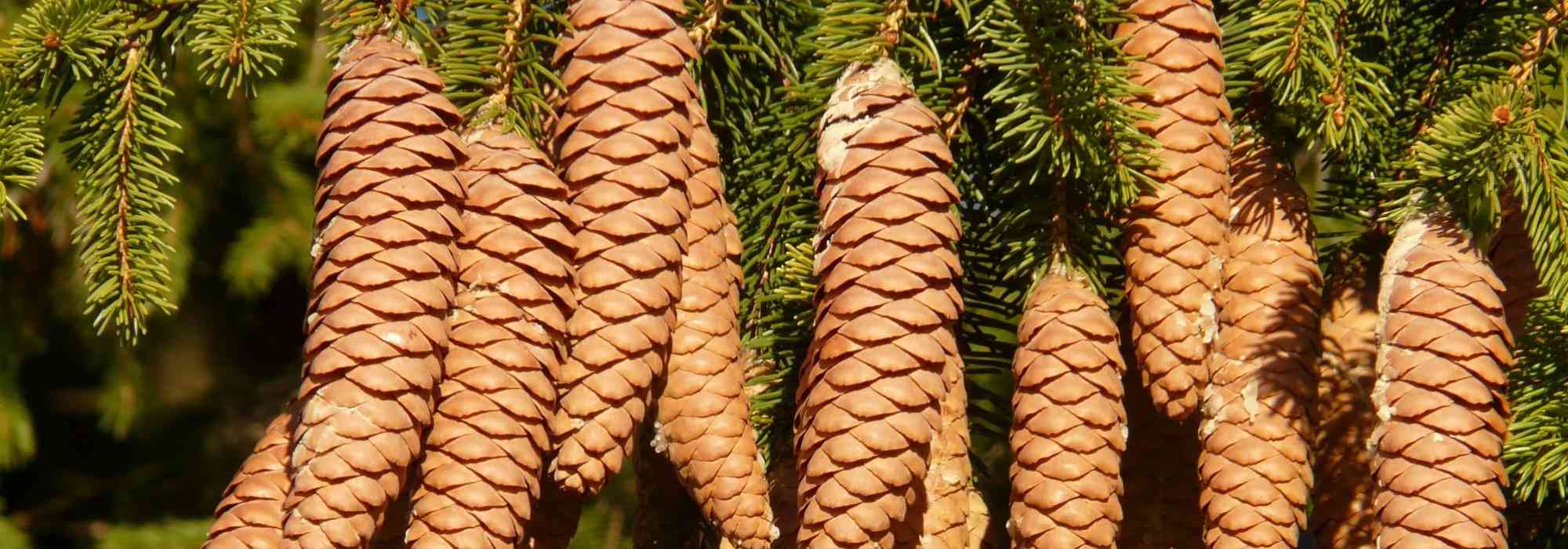
Spruces, Picea: planting, pruning and care
Contents
Picea, in a nutshell
- Spruces are large conifers adapted to harsh conditions of cold, moisture and poor soil, but tolerate urban pollution poorly.
- Their branches bearing short evergreen needles form attractive draperies adorned with pendulous cones, and are especially striking in spring when shoots emerge.
- With more than 40 species, the genus has produced many cultivars of interest in the garden for their modest to dwarf sizes, original habits, colour, texture and scent of needles, and ease of cultivation.
A word from our expert
Spruces or Picea are conifers with small sharp needles, borne singly all around the branch, often mistaken for firs or Abies whose needles are rounded and not sharp. They are often sold as “Christmas trees” instead of true firs because of similar appearance and faster cultivation in the case of the common spruce, also called Norway spruce (Picea abies).
This genus comprises nearly forty species of evergreen conifers, all native to cold temperate regions of northern hemisphere. Spruce forest in mountains, situated above deciduous trees and firs and below alpine heathland, display tall, often dark silhouettes with a rigid narrow habit, columnar or conical, under which nothing grows. Unlike firs, cones, which are initially erect, eventually hang at branch tips. Their foliage is aromatic when crushed, because it contains an essential oil much prized for its powerful energising and anti‑infective properties but also for its delicate, slightly woody scent with sweet notes of intense freshness.
There is a very wide range of cultivars better suited to garden sizes, for varied sunny to shaded situations: dwarf plants from 0.30 to 1 m, spreading, creeping forms as in Picea abies Eagle Point, globe-shaped forms such as Picea abies Nidiformis, taller specimens intended to line an avenue for example like Picea glauca Conica or weeping types such as Picea abies Inversa. Needle colour ranges through different shades of green, can be bluish as in Picea pungens Glauca Globosa, to almost white in Picea glauca Daisy’s White. Some are well suited to bonsai.
Spruces prefer sunny to shaded positions, in deep, cool, fertile and generally well‑drained soil. Over time they become indispensable companions for their comforting, reassuring presence in winter but also for the way they structure the garden and furnish even the smallest spaces with elegance, after a few years…
Description and botany
Botanical data
- Latin name Picea
- Family Pinaceae
- Common name Norway spruce, White spruce, Oregon weeping spruce
- Flowering April or May
- Height between 0.5 and 70 m
- Exposure sun, partial shade, shade
- Soil type deep, fresh and well-drained, rather acidic
- Hardiness Excellent (-40 °C)
Piceas belong to the family Pinaceae, like Pines, Firs, Cedars and Larches. The Latin name of spruce derives from the Latin pix, meaning pitch or resin, which this conifer contains abundantly in its bark, wood, needles and cones, much like Pines.
Spruces occupy humid forests from the Tropic of Cancer in Mexico to northern Siberia, from sea level up to 4 500 m in the Himalayas. Most species grow in shade and provide dense shade themselves, but some tolerate full sun well.
To distinguish Picea from Abies (firs), simply look at the crown of mature specimens, which bear pendulous oblong cones, unlike those of firs. Many natural crosses occur between spruce species that share the same range, which complicates identification. The arrangement of needles on the twig often varies with their position in the tree. Observe well-developed horizontal twigs. Cones often provide the most reliable characters.
Spruces retain a strong apical dominance so that the leading shoot often persists even in old trees, except after lightning strike or in windy sites. The pyramidal silhouette nevertheless varies with species, branch angle, degree of arching upwards or downwards, and crown width — rigid and narrow in Picea omorika, forming flowing curtains in Picea breweriana…
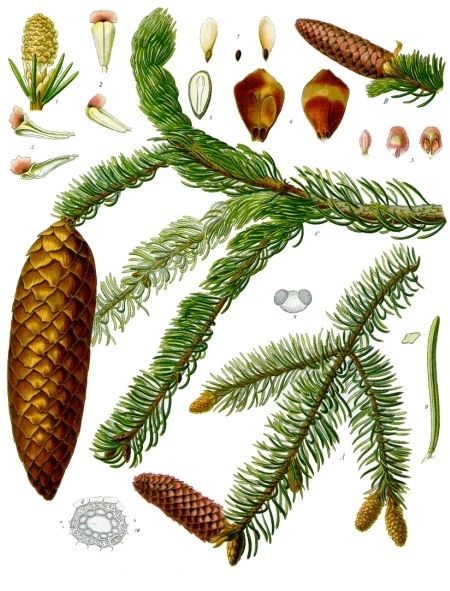
Picea abies – botanical illustration by Koehler (1887)
Norway spruce (Picea abies) is probably the best known, planted extensively in regions such as the Morvan in particular to supply inexpensive “Christmas trees”. It is often found dominating in small gardens where it can overpower surroundings with dense shade, and is recognisable by its regular pyramidal habit with slightly arched branches and its fresh green colour. It grows very fast and easily reaches 36 m in height. It is native to a broad area from the mountains of Scandinavia to north-west Russia via central Europe, and is cultivated as a forest species as far east as the United States. It has produced a number of dwarf varieties much appreciated in gardens, such as Picea abies ‘Acrocona’, noted for a profusion of small bright pink young cones at branch tips, very decorative even on young trees. The Sitka spruce is the other most commonly planted species because of its very rapid growth and low soil and climate demands, allowing it to be grown even in Ireland on peaty moorland. It is native to the west coast of the United States, from California to Alaska — including Sitka, an area with very high rainfall (2 200 mm) and a climate approaching polar conditions similar to the Scottish Highlands. It reaches the greatest heights in the genus at around 70 m with trunks 4–5 m in diameter (a 97 m specimen recorded in British Columbia).
Spruce needles are fairly short (6 to 30 mm), borne singly in a spiral along twigs and are generally quadrangular in cross-section, without white bands of stoma on Picea abies, with exceptions such as Serbian spruce (Picea omorika) and Sitka spruce, which have flattened needles with two white bands beneath. Needles remain on a twig for 7 to 10 years. Pulling on a generally prickly needle will tear off a bit of bark because the needle is decurrent, that is inserted on a small cushion which persists when the needle falls. A fir needle, by contrast, leaves a neat round scar when removed. The shape of the leafy twig resembles a bottlebrush due to the inward curve of the needles towards the top of the horizontal twig. When spruce needles fall after several years they leave a , not pleasant to stroke. This uninviting aspect is offset by the comfort offered by the buttresses at the base of the trunk, which serve as armrests. The bark is scaly and thin, buds are conical, less than 5 mm, and non-resinous.
Male and female flowering of spruces occur on the same tree but on separate inflorescences. Male aments borne in the mid and lower parts of the tree form small erect clubs 10–20 mm long, orange turning yellow when they release pollen in April or May, spectacular in Picea orientalis. Female conelets, borne in the mid and upper parts of the tree, form erect fleshy cones 10–25 mm long, green or purplish-red. Cones with very small bracts become pendulous after fertilisation and fusiform, (12–15 cm in Picea abies), lignified similar to those of firs and much less tough than those of pines, reach ripeness in late summer–autumn and release winged seeds from the top of the tree. Cones of Picea orientalis show a splendid purple colour.
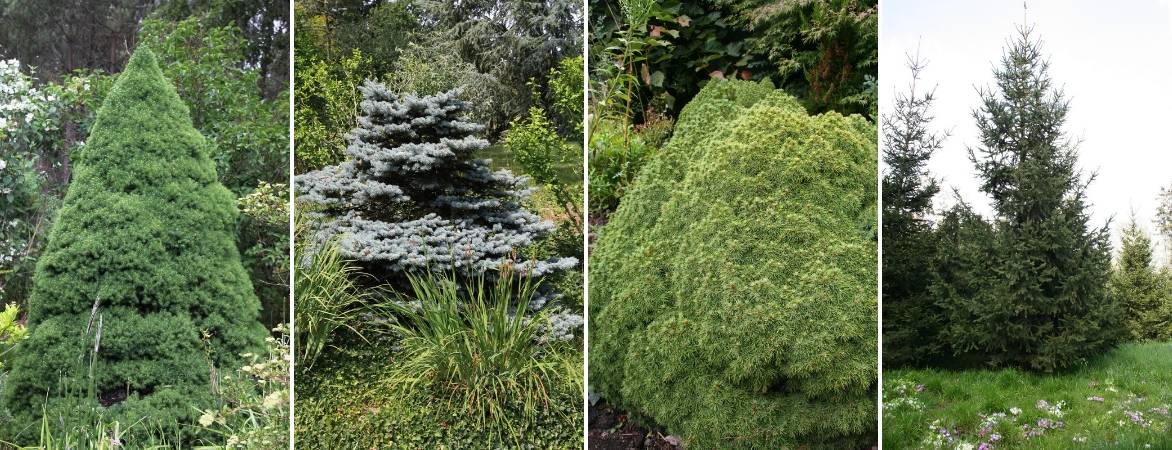
Some spruces: Picea glauca ‘Conica’, Picea pungens ‘Glauca Globosa’, Picea glauca ‘Alberta Globe’ and Picea abies
Wood of Norway spruce is a light-coloured timber valued for frame construction and for pulp. Its bark is still used in Germany for tanning leather while turpentine oil is extracted from its twigs.
A Sitka spruce from ancient forests can produce timber as strong as steel, used for shipbuilding or for soundboards of grand pianos, harps or violins.
Main spruce varieties
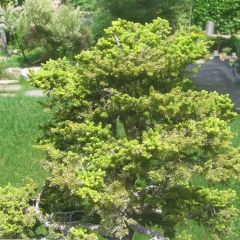
Picea jezoensis subsp. hondoensis
- Height at maturity 40 m
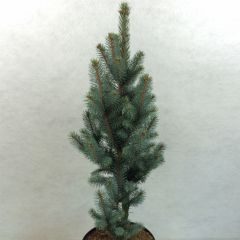
Picea pungens Iseli Fastigiate - Blue Spruce
- Height at maturity 7 m
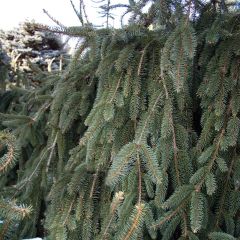
Picea abies Inversa - Norway Spruce
- Height at maturity 6,50 m

Picea glauca Sanders Blue - White Spruce
- Height at maturity 3 m
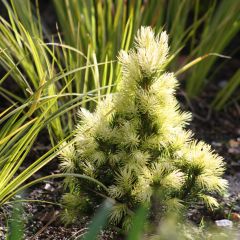
White spruce - Picea glauca Daisys White
- Height at maturity 1,50 m
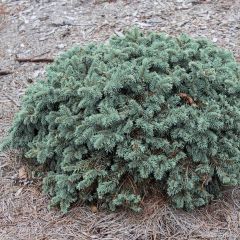
Picea pungens Waldbrunn - Blue Spruce
- Height at maturity 70 cm
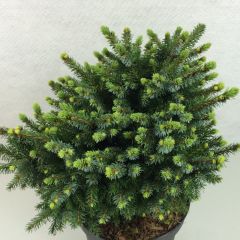
Picea omorika Beskid - Serbian Spruce
- Height at maturity 80 cm
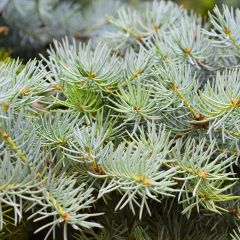
Picea abies Eagle Point - Norway Spruce
- Height at maturity 50 cm
Discover other Picea
View all →Available in 1 sizes
Available in 1 sizes
Available in 1 sizes
Available in 1 sizes
Available in 1 sizes
Available in 1 sizes
Available in 1 sizes
Available in 2 sizes
Available in 1 sizes
Available in 1 sizes
Planting
Where to plant spruce?
Spruces appreciate cool, humid atmospheres and dislike atmospheric pollution. They prefer cool soils with an acidic to neutral pH but can tolerate relatively dry soil such as Picea abies or pungens. Picea rubens and pungens both tolerate lime unlike most spruces. Spruces tolerate wind well and have excellent hardiness.
Spruce root system is generally shallow and extensive, so they do not tolerate transplanting well. Spruce forests often planted very densely have no understorey because of dense shade they provide.
If your soil is waterlogged, opt for a variety of Picea mariana (black spruce) or even Picea sitchensis. The latter particularly favours oceanic climate or areas often shrouded in fog, below 500 m altitude, such as Brittany, Normandy, Massif Central, Béarn or Basque Country.
Growth is slow in Picea glauca or Picea rubens whereas it can be very rapid in most other species, except dwarf cultivars.
When to plant?
Prefer autumn, October–November, to plant spruces so roots can spread well before summer, otherwise in February–March.
How to plant?
If planting a large specimen, it may be vulnerable to windthrow and have difficulty establishing (except Sitka spruce, which is easy to transplant).
- Immerse pot in a bucket of water to thoroughly moisten it.
- Dig a wide hole at least three times wider than rootball because roots remain fairly shallow and spread widely.
- Avoid planting spruce too close to a bush bed unless they are dwarf varieties.
- Add a few handfuls of sand and gravel to ensure good drainage around roots. In heavy soil, choose planting on a mound or within a rockery.
- Apply a dose of crushed horn if soil is sandy.
- Place plant in planting hole.
- Replace soil and firm lightly.
- Water.
Care
Despite their robustness in often very harsh climates, these trees are easily stressed by drought or pollution and can be fragile, susceptible to red spider mites such as Picea glauca Albertiana Conica, for example: avoid planting near a light-coloured wall, which causes needle drop. It is important to place spruce in cool conditions and to mist young plants with a jet of water in the evening during a heatwave.
Squirrels and rabbits sometimes cause severe damage to trunks of young spruce. Rust and pineapple gall caused by adelgids are fairly common attacks but not very damaging to trees.
Spruce should not be pruned.
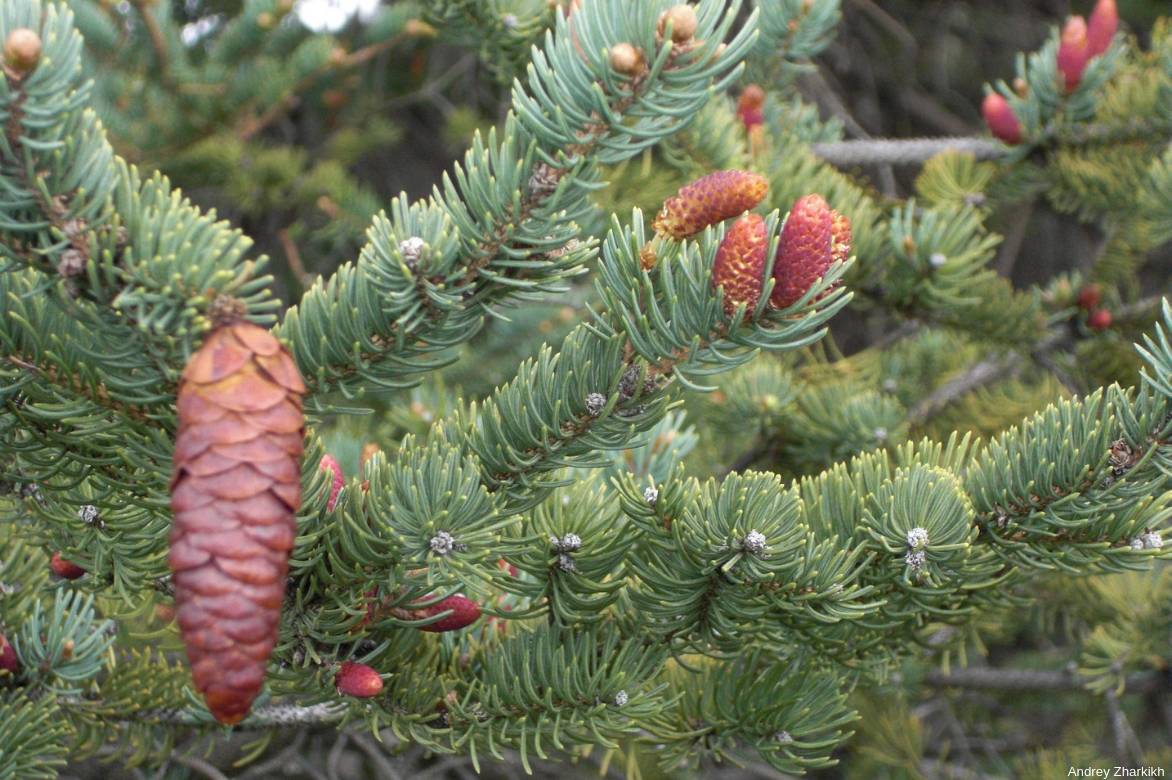
Cones of Picea glauca
Multiplication
Simplest propagation is by sowing spruce seeds, which keep for a very long time when stored dry at low temperature. Cultivars are obtained by graft or propagation by cuttings in May–June.
Propagation by cuttings
- Prepare a pot deep by filling it with potting compost mixed with sand.
- Remove tips of August-ripened lateral shoots by pulling on them to obtain a heel.
- Remove needles located near base of the cutting.
- Insert them up to two-thirds of their length, ensuring they do not touch.
- Firm down, water then place them in a warm, humid, covered environment.
- In autumn, separate rooted cuttings and pot them into deep pots.
- Plant out young plants the following autumn in open ground.
Sowing
- Sow seeds as they are or after a period of cold, moist stratification in a sandy mix. Germination is generally rapid.
- Keep conditions cool.
- Prick out young spruce plants in September.
Uses and associations
Plant original specimens of medium to large growth as solitary specimens on a short grass meadow or on a large rockery such as Picea abies ‘Inversa’ with an entirely trailing habit which, without staking, spreads over the ground. Place Picea breweriana prominently facing a mountain chalet, for example. It will be marvellous with its branches bearing non-prickly needles that form graceful trailing draperies 10 to 15 m high. The bluish colouring of Colorado spruces (Picea pungens Jeddeloh, Glauca Globosa or Koster) or of the Arizona blue spruce (Picea engelmanii Glauca) is of rare intensity; species to plant in full sun in any soil and fairly tolerant of drought.
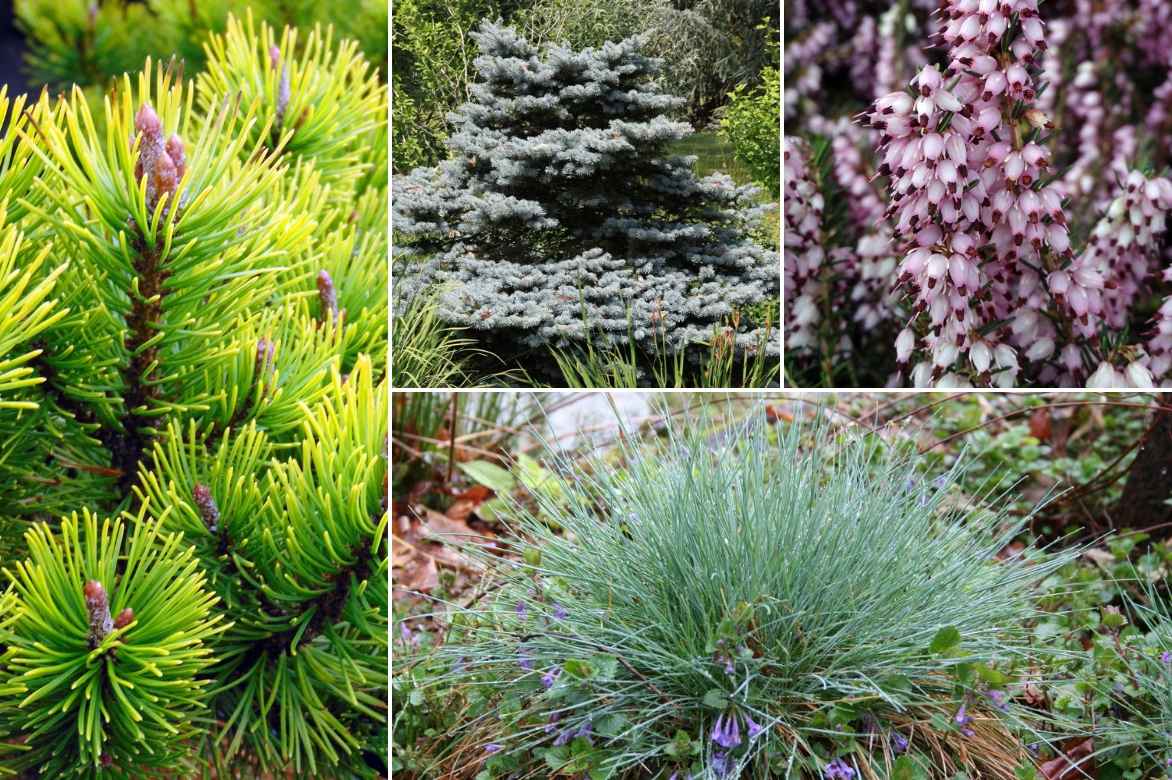
An idea for a combination: Pinus mugo ‘Ophir’ and Picea pungens ‘Glauca Globosa’ on a patchwork of heathers (Erica darleyensis ‘Ghost Hills’ for example) and fescues (Festuca glauca)
Dwarf specimens such as Picea abies ‘Nidiformis’ which forms a true stork’s nest with very bright apple-green young shoots, are excellent in rockery or in containers combined with other dwarf conifers, heathers, rhododendrons or Japanese azaleas. Forms with glaucous, silvery foliage such as Picea glauca, Picea pungens bring a sunny touch that contrasts with the dark greens of Picea orientalis, for example. The white dwarf spruce ‘Daisy’s White’ will brighten the scene with its platinum-blond shoots in spring which you can combine with the red shoots of a Photinia fraseri ‘Little Red Robin’ or the purple shoots of a Pittosporum tenuifolium ‘Purpureum’.
In a contemporary garden with geometric lines and masonry features, plant small specimens with slow growth to establish permanence, reinforce the garden’s graphic structure and diffuse its resinous essential oils. You can do the same on a stream bank where the rocks help highlight the fine textures of spruce branches.
In a zen garden spirit, pair Hondo spruce (Picea jezoensis var. hondoensis) with deciduous or evergreen species native to Japan such as Japanese maples, Japanese cherries, bamboos, nandinas, aucuba…
Did you know?
Picea omorika, Serbian and Bosnian spruce, is a rare species listed on the Red List of endangered species. It is recognised by its very columnar silhouette, whose upper branches rise and form a curious tuft in the crown, a very majestic specimen with dark violet cones that suits large gardens.
Sitka spruce, widely planted in Irish sphagnum heathland, contaminates salmon streams downstream because of decomposition of its acidic needles mixed with turf.
Further reading
Discover our range of Picea.
- Subscribe!
- Contents
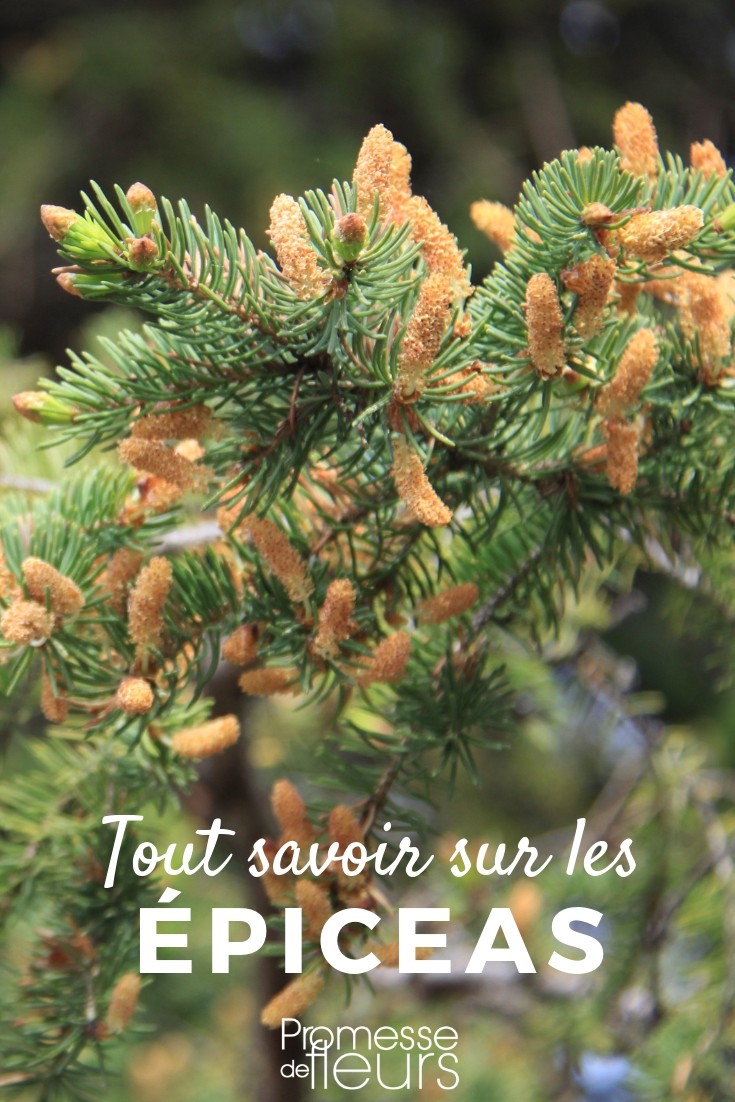































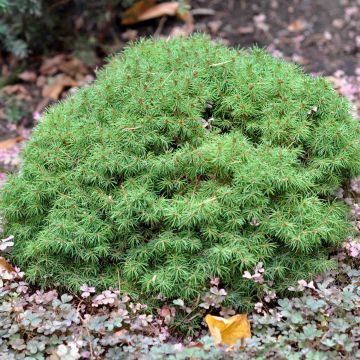
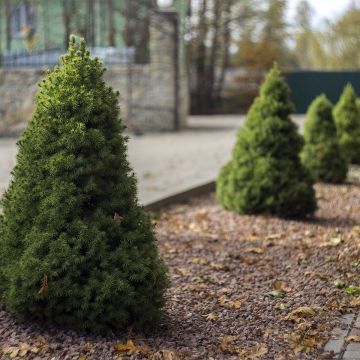

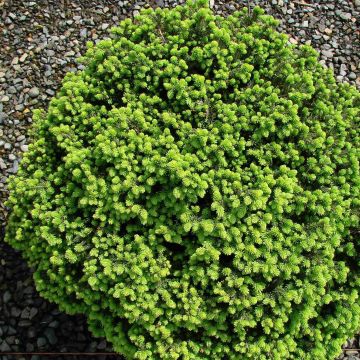

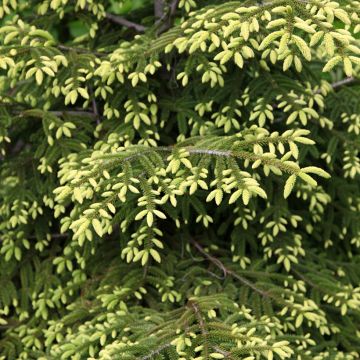
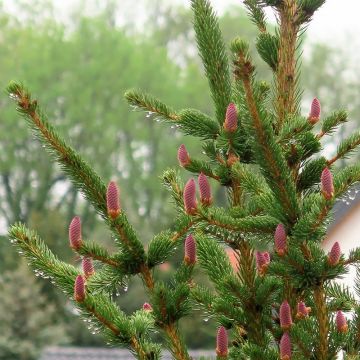
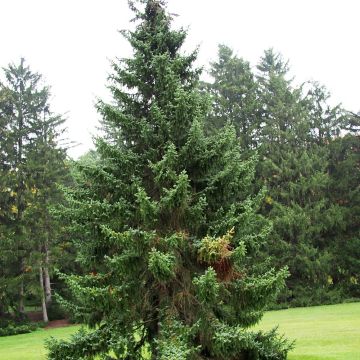
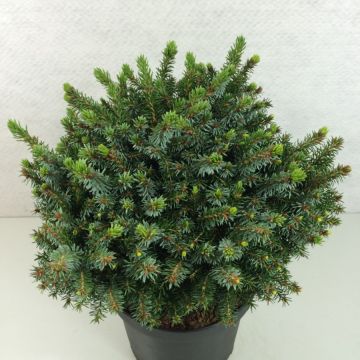
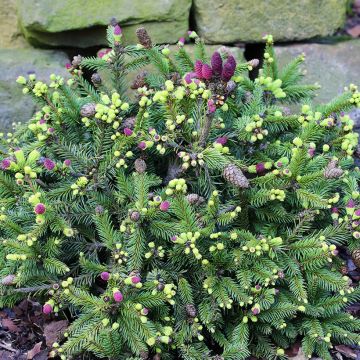
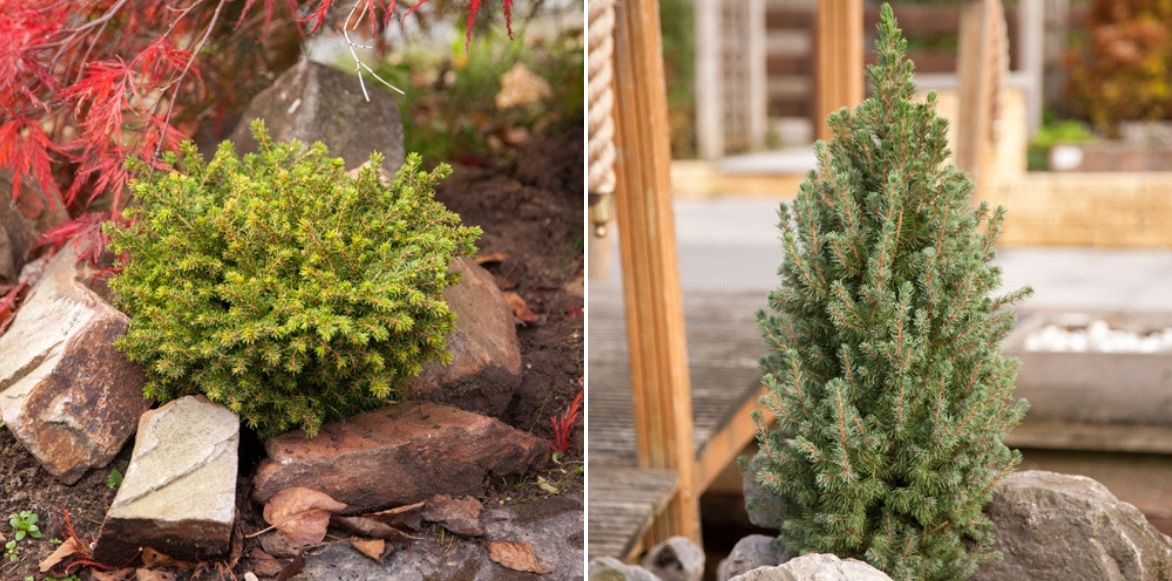
Comments